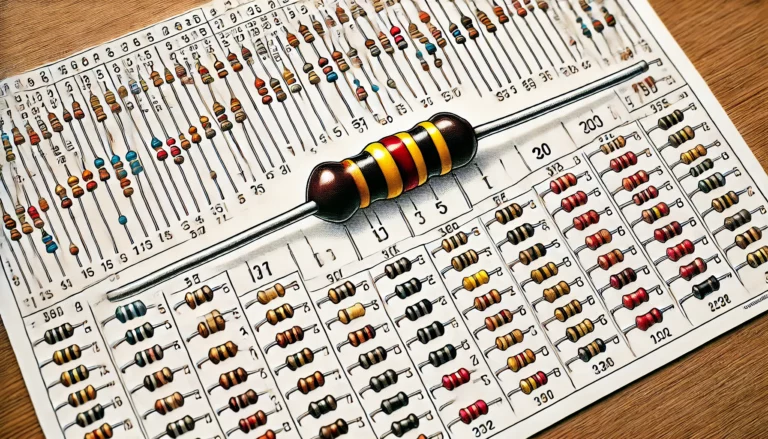What is the Color Code for Resistors?
Understanding the color code for resistors is fundamental for anyone involved in electronics. This system allows you to quickly determine the resistance value of a resistor, which is crucial for designing and troubleshooting electronic circuits. This guide will provide a comprehensive overview of the resistor color code, how to read it, and tips for remembering the color sequences.

The Basics of Resistor Color Codes
Resistors are a common component in electronic circuits, and they come in various shapes and sizes. To indicate their resistance value, resistors use a color-coding system. This system is standardized and universally recognized, making it easy to identify resistor values regardless of the manufacturer.
Understanding the Color Bands
Each resistor has several colored bands around its body, typically three to six. These bands represent the resistor’s value and tolerance. Here’s a breakdown of what each band signifies:
1. Significant Figures: The first two or three bands (depending on the resistor) represent significant figures of the resistor’s value. 2. Multiplier: The next band indicates the multiplier, which is a factor by which the significant figures are multiplied. 3. Tolerance: The final band shows the tolerance, which indicates the accuracy of the resistor’s value.
How to Read Resistor Color Codes
Reading resistor color codes can seem daunting at first, but with practice, it becomes straightforward. Let’s go through the process step by step.
The Color Code Chart
To read resistor color codes, you need to be familiar with the color code chart. Each color corresponds to a specific number:
| Color | Digit | Multiplier | Tolerance |
|---|---|---|---|
| Black | 0 | x1 | |
| Brown | 1 | x10 | ±1% |
| Red | 2 | x100 | ±2% |
| Orange | 3 | x1,000 | |
| Yellow | 4 | x10,000 | |
| Green | 5 | x100,000 | ±0.5% |
| Blue | 6 | x1,000,000 | ±0.25% |
| Violet | 7 | x10,000,000 | ±0.1% |
| Gray | 8 | x100,000,000 | ±0.05% |
| White | 9 | x1,000,000,000 | |
| Gold | x0.1 | ±5% | |
| Silver | x0.01 | ±10% | |
| None | ±20% |
Step-by-Step Guide to Reading Resistor Color Codes
- Identify the Bands: Start by identifying the colored bands on the resistor. Hold the resistor with the tolerance band (usually gold or silver) to the right.
- Read the Significant Figures: The first two (or three) bands represent the significant figures. Use the color code chart to convert these colors to numbers.
- Determine the Multiplier: The next band is the multiplier. Use the chart to find the corresponding multiplier value.
- Calculate the Resistance: Combine the significant figures and multiply by the multiplier to get the resistance value.
- Check the Tolerance: The final band indicates the tolerance, which tells you how accurate the resistor’s value is.
Example Calculation
Let’s go through an example. Suppose you have a resistor with the color bands: Red, Violet, Yellow, and Gold.
- Significant Figures: Red (2) and Violet (7) = 27
- Multiplier: Yellow (10,000) = 27 x 10,000 = 270,000 ohms (270 kΩ)
- Tolerance: Gold = ±5%
So, the resistor’s value is 270 kΩ with a tolerance of ±5%.
Tips for Remembering Resistor Color Codes
Memorizing the color code chart can be challenging, but there are a few mnemonic devices that can help. Here are a couple of popular ones:
1. BB ROY of Great Britain had a Very Good Wife:
- Black = 0
- Brown = 1
- Red = 2
- Orange = 3
- Yellow = 4
- Green = 5
- Blue = 6
- Violet = 7
- Gray = 8
- White = 9
2. Better Be Right Or Your Great Big Venture Goes Wrong:
- Each word represents a color in the same order as the first mnemonic.
Using these mnemonic devices can make it easier to recall the sequence of colors and their corresponding numbers.
Common Mistakes and How to Avoid Them
When reading resistor color codes, beginners often make a few common mistakes. Here are some tips to avoid these pitfalls:
1. Misreading the Tolerance Band: Always make sure the tolerance band is on the right side. This band is usually gold or silver and is slightly separated from the others. 2. Confusing Similar Colors: Colors like red and brown or blue and violet can be easily confused. Ensure you have good lighting and, if needed, use a magnifying glass. 3. Forgetting the Multiplier: Don’t forget to apply the multiplier after determining the significant figures. This step is crucial for getting the correct resistance value.
Advanced Topics: Resistors with More Bands
Some resistors have more than four bands. These resistors offer more precise values and additional information. Here’s a brief overview:
1. Five-Band Resistors: These include three significant figure bands, a multiplier, and a tolerance band. This allows for more precise resistance values. 2. Six-Band Resistors: These add a temperature coefficient band to the five-band system. The temperature coefficient indicates how much the resistor’s value changes with temperature.
Example of a Five-Band Resistor
Consider a resistor with the bands: Brown, Black, Black, Red, and Brown.
- Significant Figures: Brown (1), Black (0), Black (0) = 100
- Multiplier: Red (100) = 100 x 100 = 10,000 ohms (10 kΩ)
- Tolerance: Brown = ±1%
So, the resistor’s value is 10 kΩ with a tolerance of ±1%.
Conclusion: Mastering Resistor Color Codes
Understanding the color code for resistors is essential for anyone working with electronics. This knowledge allows you to quickly and accurately determine resistor values, ensuring your circuits function correctly. By using the color code chart, practicing with examples, and remembering mnemonic devices, you can become proficient in reading resistor color codes. Keep this guide handy as a reference, and soon, interpreting resistor values will become second nature.





